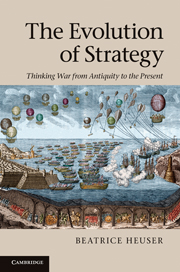Book contents
- Frontmatter
- Contents
- Acknowledgements
- A note on referencing
- Part I Introduction
- PART II Long-term constants
- PART III The Napoleonic paradigm and Total War
- PART IV Naval and maritime Strategy
- PART V Air Power and nuclear Strategy
- 12 War in the third dimension
- 13 Four schools of air power
- 14 Nuclear Strategy
- PART VI Asymmetric or ‘small’ wars
- PART VII The quest for new paradigms after the World Wars
- Bibliography
- Index
13 - Four schools of air power
from PART V - Air Power and nuclear Strategy
Published online by Cambridge University Press: 05 June 2012
- Frontmatter
- Contents
- Acknowledgements
- A note on referencing
- Part I Introduction
- PART II Long-term constants
- PART III The Napoleonic paradigm and Total War
- PART IV Naval and maritime Strategy
- PART V Air Power and nuclear Strategy
- 12 War in the third dimension
- 13 Four schools of air power
- 14 Nuclear Strategy
- PART VI Asymmetric or ‘small’ wars
- PART VII The quest for new paradigms after the World Wars
- Bibliography
- Index
Summary
The strategic/city bombing school was only one of four, of which three existed from the beginning of the history of aviation, but several of which would only approach realism with further developments of technology. The strategic/city bombing school at least initially was inspired by Social Darwinist concepts of ‘national wars’ in which nation was pitted against nation in the war effort and no target was out of bounds. It achieved its summit with the nuclear bombing of Hiroshima and Nagasaki.
The second is the military targets school, often referred to as tactical, loved best by the other two services. The main tasks of the air force under this heading would be to provide close air support (CAS) for the other two services, or, beyond the actual field of battle, reconnaissance and the targeting of enemy military forces (and those only) that were approaching the battlefield from afar.
- Type
- Chapter
- Information
- The Evolution of StrategyThinking War from Antiquity to the Present, pp. 313 - 350Publisher: Cambridge University PressPrint publication year: 2010

